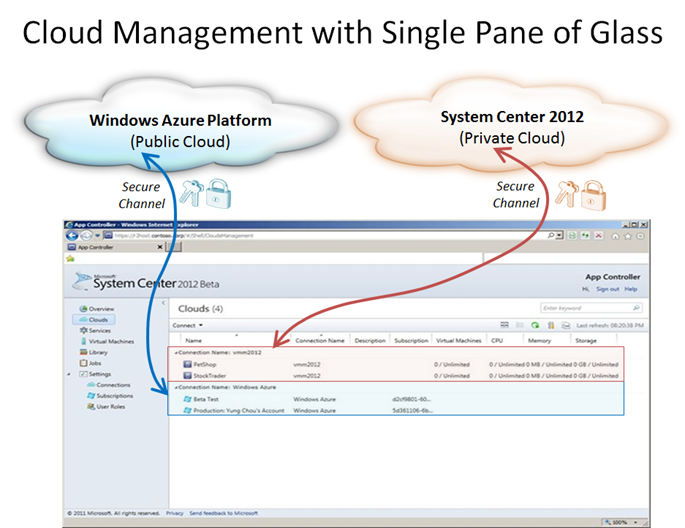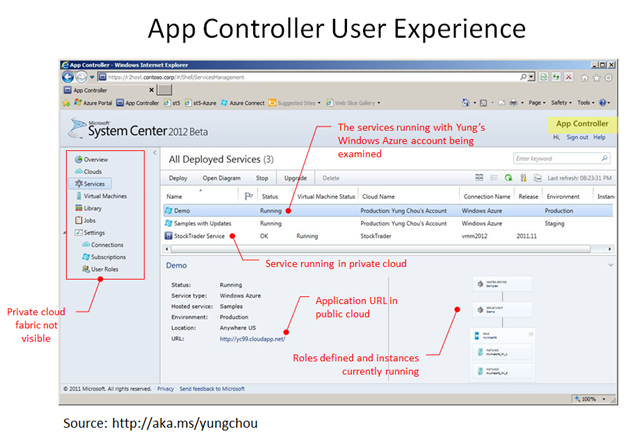System Center Virtual Machine Manager as Private Cloud Enabler (5/5): App Controller
Among the members of System Center 2012 release, App Controller seems getting more attention than the others in the suite. And the reason is probably because App Controller directly answers the need  to have a single pane of glass to manage both public and private clouds.
to have a single pane of glass to manage both public and private clouds.
A single pane of glass means seamless integration of multiple components, aggregate of information from multiple sources, fewer passwords to manage, less training needed, fewer helpdesk calls, more user productivity, higher satisfaction, and on and on and on. The long-term impact upon ROI and user satisfaction by providing a mechanism to manage resources deployed on premise and off premise with an integrated view can be very significant.
Here, in this last article of this 5-part series on VMM 2012 as listed below, I would like to offer a quick overview of App Controller, an essential add-on of VMM 2012.
- Part 1. Private Cloud Concepts
- Part 2. Fabric, Oh, Fabric
- Part 3. Deployment with Service Template
- Part 4. Working with Service Templates
- Part 5. App Controller (This article)
Here I want to encourage you to download System Center 2012 trials available from this download Page , practice and experiment, get a head start in becoming the next private cloud expert in your organization.
A View of All
For public cloud, private cloud, and something in between, App Controller has a lot to offer to both a cloud administrator and a self-service user. App Controller is an add-on of VMM 2012 and a web-based interface configured as a virtual directory in IIS. A connection between App Controller and applications deployed to Windows Azure Platform in public cloud requires internet connectivity, certificates, Windows Azure subscription ID and credentials. To connect to a private cloud, a self-service user will log in the associated VMM 2012 server with AD credentials. The access control is a role-based model by Windows Authorization Manager, i.e. AzMan. So what a self-user can see or do are all trimmed and predefined.
The following shows App Controller connecting with two private clouds (PetShop and StockTrader) deployed by VMM 2012 and two subscriptions (Bata Test and Yung Chou’s production account) of Windows Azure Platform in public cloud. In this setting with App Controller, I was able to deploy and manage StockTrader as a private cloud in VMM 2012, at the same time publish and administer Windows Azure applications in public cloud, both requiring and with secure channels.
In addition to the ability to connect to a private cloud and a public cloud at the same time, another distinct feature of App Controller is to enable an authorized user to deploy a service to a private cloud in VMM 2012 without the need to reveal the underlying private cloud fabric. Technically this is such a complex infrastructure can be easily presented with convoluted processes and confusing settings. Instead, a UI gracefully designed with a keep-it-simple approach offers a quite remarkable user experience.
Notice in the App Controller UI, fabric is not visible despite a logon is with VMM admin privileges. This allows a cloud administrator to enable service owners to deploy applications to private clouds based on their needs in a self-servicing fashion, while still having a total control of how the infrastructure is configured and managed which is abstracted by the fabric. This is a great story.
Service Upgrade with App Controller
Personally I find the upgrade of a service with App Controller most exciting. To upgrade a service running in a private cloud deployed by VMM 2012, a self-service user can simply apply a new service template to an intended instance of the service. Technically it can be operationally carried out in a few mouse clicks. Depending on the Upgrade Domain and Fault Domain (similar to what are in Windows Azure Platform) of the service and what kind of updates are made to the service, there may or may not any service outage required. Here just to highlight the process, the following captures the App Controller screen for a self0service user to confirm upgrading a running instance of the StockTrader service from release 2011.11 to 2011.11.24.
Notice that in VMM 2012, the self-service model for deploying a private cloud is via VMM 2012 admin console or App Controller. The formal is a Windows application, while the latter is a web-based interface. There is also a self-service portal one can install for just VM-based deployment.
Closing Thoughts
VMM 2012 is a begging of a new era. Infrastructure and deployment can no longer be the excuses for IT to prolong, delay, and procrastinate. The expectation now is not what or if, but how fast IT can deliver it.
Although the establishments already deployed may not be reconfigured, reengineered, or replaced as quickly as people would like to see. Customer’s expectations continue to raise. The mindset of IT pros must change from “how I may not be able to deliver it” to “ what is a customer’s needs and how soon IT will make it happen”.
A few years ago, many thought virtualization would be relevant to only enterprise IT, while today virtualization has become a core skill set and no longer a specialty. Those who still believe private cloud is remote and not applicable, may wake up tomorrow and realize everything is moving and changing towards cloud much faster and in a larger scope than anticipated. Private cloud is a highly technical subject and there is simply, in my view, no shortcut to master it. Investing time and learning VMM 2012 and App Controller in the old-fashioned way by getting hands dirty is what I have done and will continue doing. Start today. Start now. Start from building your VMM test lab. Study, practice, and deploy your own cloud. And you are then on a road to becoming the next private cloud expert in your organization.


